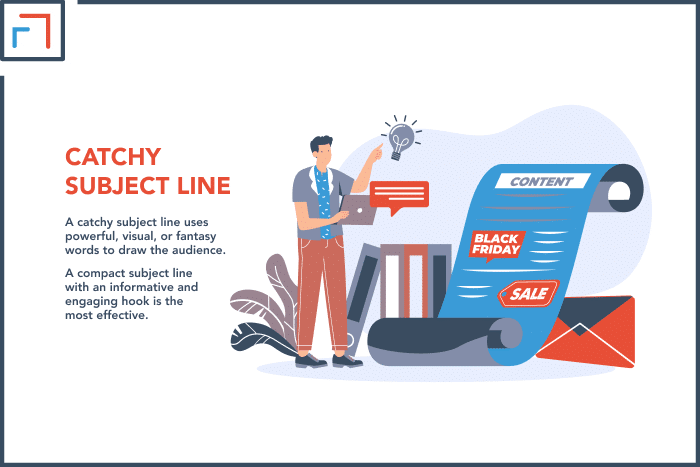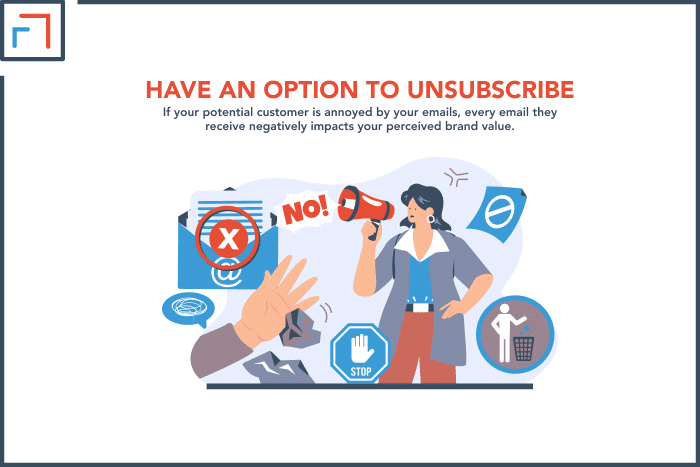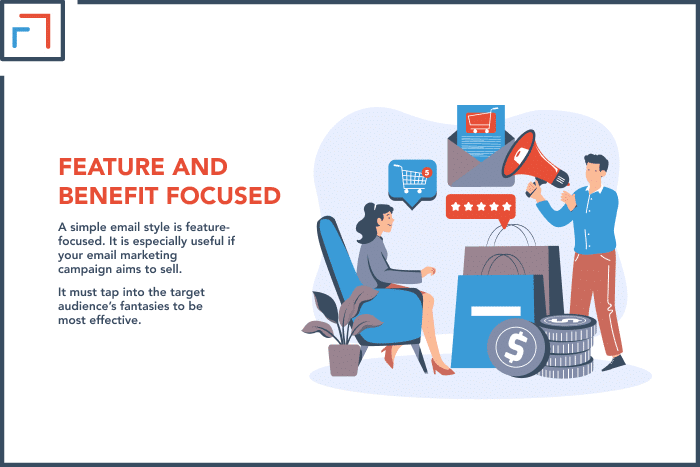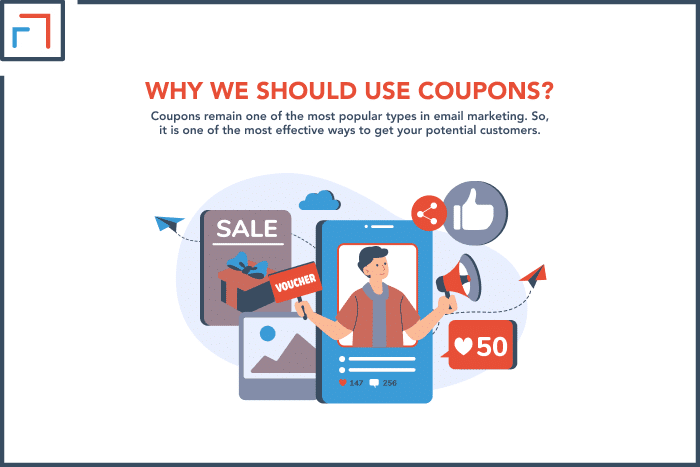Marketing is an art, and when the medium of this art is email, it’s challenging to pull it off. However, it’s worth all the effort because email marketing allows businesses to foster strong relationships with customers on a budget.
You must put a subject line, a compelling preheader, and an option to unsubscribe in your marketing email. Email marketing content could include mini-stories and benefit-focused features to drive the audience to act. Coupons in emails are also highly effective in driving sales.
You can use email marketing to create campaigns that achieve your desired outcome. But what should you put in a marketing email?
Must-haves in a Marketing Emails
Whatever the goal of your email marketing campaign might be, there are some must-haves in every campaign:
1. Catchy Subject Line (Hook 1)
A catchy subject line uses powerful, visual, or fantasy words to draw the audience. While it should compel the audience to open the email, it should also give them information on what’s inside.
That being said, ensure the subject line is relevant to the content. If your subject line merely serves as a clickbait, you won’t benefit from it.
Your emails might get a higher open rate initially. But in the long run, it will lead to more spam filtering and unsubscriptions.
Also, never include words like “free” and “buy” in your subject line because these are spam triggers.
You might think these words can get your audience to open the emails, but they are mostly marked as spam by email hosts, putting all your effort and money down the drain.
A compact subject line with an informative and engaging hook is the most effective.
Subject lines that are catchy and less than 50 characters attain a 12% higher open rate and a 75% higher click-through rate (Source)

2. Compelling Pre-header (Hook 2)
An email preheader is a snippet or a teaser of the content of the email. It is also known as the second subject line because the recipient can view both when they open their inbox or receive a notification.
Because the subject line and the preheader are visible to the recipients, they should not repeat the same message. Like the subject line, a preheader should be relevant, compact, and convincing.
A compelling subject line and an effective email preheader are hooks for the audience to open the email.
24% of recipients read an email’s preview text to decide whether to open it (Source).
3. Option to Unsubscribe
According to the CAN-SPAM Act, you should add an opt-out or unsubscribe option in all your commercial emails, whether sending it in bulk or to one recipient at a time.
Businesses are also responsible for catering to opt-out requests within 10 business days.
Non-compliance to the Act can be quite costly as each email in violation of the Act can get a penalty of $50-$120 (Source)
If your potential customer is annoyed by your emails, every email they receive negatively impacts your perceived brand value.
An even more damaging act is marking the email as spam. When your potential audiences don’t see an unsubscribe option, the spam mark could harm your domain’s reputation.
A decreased domain reputation means that your emails are more likely to be marked spam by email service providers in the future. This will impact your email marketing performance metrics in the long run.
Adding an option to unsubscribe from your mailing list might seem like it’s opposing the aim of the email, but it is beneficial too.

Content to Put in Your Email Marketing
Catchy subject lines and hooks will get your target audience to open the email.
But the actual purpose of any email marketing campaign is to drive action, be it reading your blog, watching your YouTube video, getting access to exclusive content, participating in a webinar, visiting your website, or purchasing.
You can read about more uses of email marketing in my article on Where Can You Use Email Marketing?
Here are the 3 email styles that you can choose from when you’re crafting email content:
1. Feature and Benefit Focused
A simple email style is feature-focused. It is especially useful if your email marketing campaign aims to sell.
But feature-focused emails must tap into the target audience’s fantasies to be most effective.
For instance, “Our weight loss product has a mix of 8 exotic nutrients” is a feature, but “Reveal a leaner, healthier you with our product’s mix of 8 exotic nutrients” is a fantasy-focused feature.
You can also call it the benefit that the audience will get from each feature of your product.
Benefit-focused features also work for promoting content like newsletters and free-value content.

2. Mini Stories
Features tell, but stories sell. If your email is a long list of product features, it won’t impact or resonate with the audience.
But if you add a mini story to your email, you will see a higher click-through rate than simple feature selling.
But mini stories are also of two kinds. One tells the story of the brand or the entrepreneur, and the other illustrates a picture for the audience.
Testimonial Story
The illustration is often a fictional or actual story of someone who benefitted from your product – much like a testimonial.
Brand Story
When you tell the brand’s story through email, you aim to establish a personal, direct relationship with your potential customer.
Here are some questions that can get you started on crafting a mini story for your business to put in your email:
- Who is making the product?
- What inspired creating the product?
- What obstacles did you need to overcome to develop the product?
- How was the product tested?
| Example Explanation Let’s take a look at some mini story starters for a hand-made face mask business to get you inspired: Brand Story Starter Examples: I am one of the millions of families whose jobs were impacted by COVID-19. Now I’m creating hand-made face masks using my skills as a designer that I developed over the years. And ever since I started, many celebrities I could only dream of meeting have ordered my face masks. And they love them. What gives me an edge in the market is my passion for design and the pure love that I put into each face mask (Fun Fact: my 5-year-old usually helps me with cutting) Testimonial Story Starter Example: I stepped into the party, and all eyes were on me. I took a few steps and scanned the room for a familiar pair of eyes. I saw her walking towards me, wearing the face mask I gifted her yesterday – glittering and gleaming in the warm yellow lights. |
3. Coupons
Email marketing takes many forms, including promotional content, free-value content, and newsletters.
But discounts or coupons remain one of the most popular content types in email marketing.
70% of email marketing subscribers are looking for promotions, discounts, and deals in emails from companies and brands (Source).
Even though customers love discounts and offers, if you continually send discount offers through email, it can negatively impact the perceived brand equity and value.
So, it is one of the most effective ways to get your potential customers through your sales funnel, converting them to customers.
If you’re new to the world of sales funnels, do check out my article on what are sales funnels and how do they work!
But don’t overuse this strategy, as it can harm your brand image and impact your profitability in the long run.

Final Words
Email marketing can be done in different ways. But if you’re starting, it is essential to know what you should and should not put in email marketing.
Elements in the email that strike the right chords with the potential audience have the power to achieve quick business wins.
Adding all the must-haves and focusing on one of the three styles discussed in this article allows you to grab the opportunities that email marketing presents for your business.
